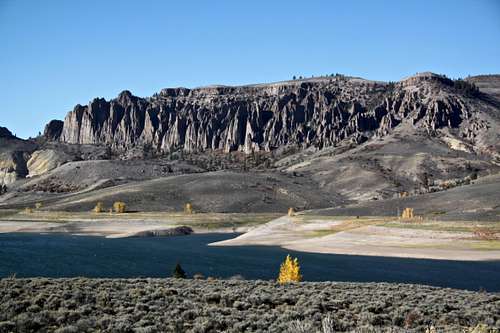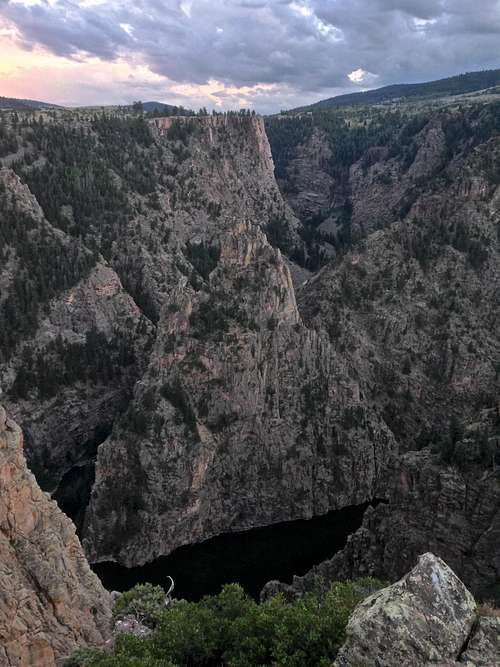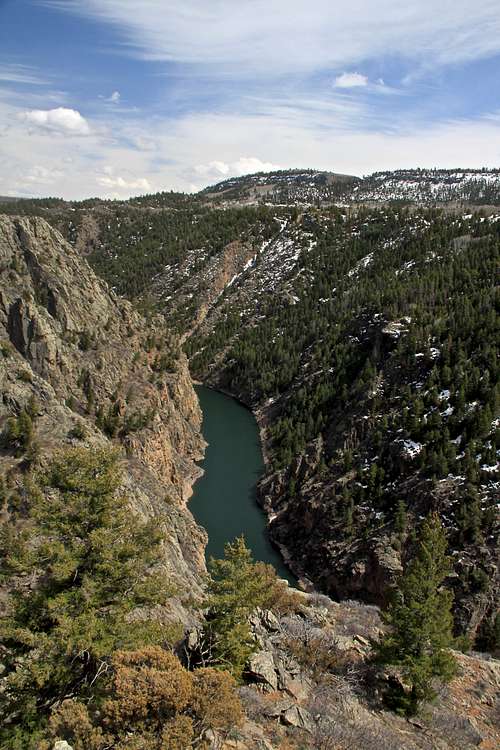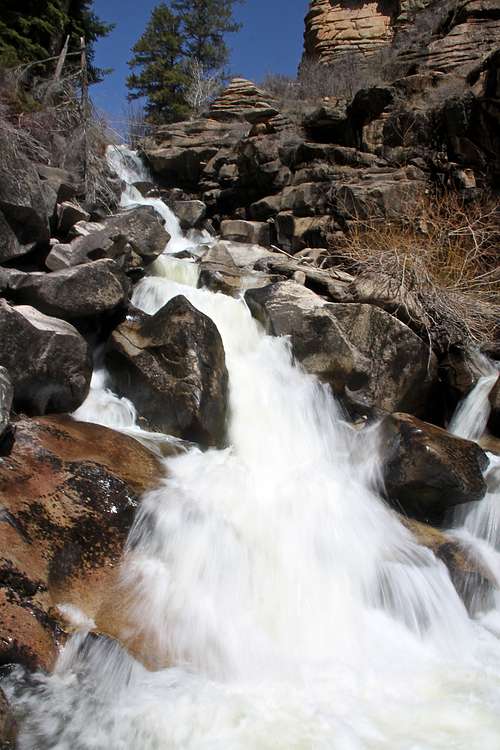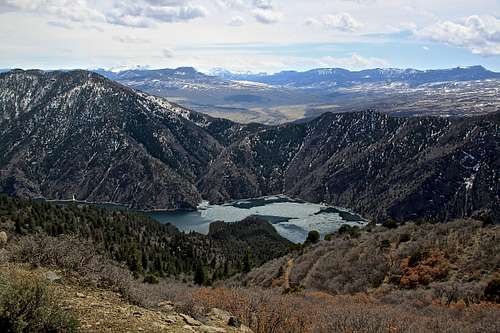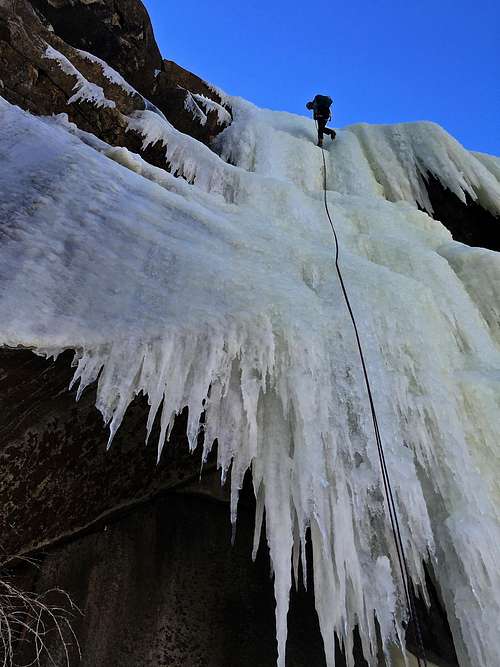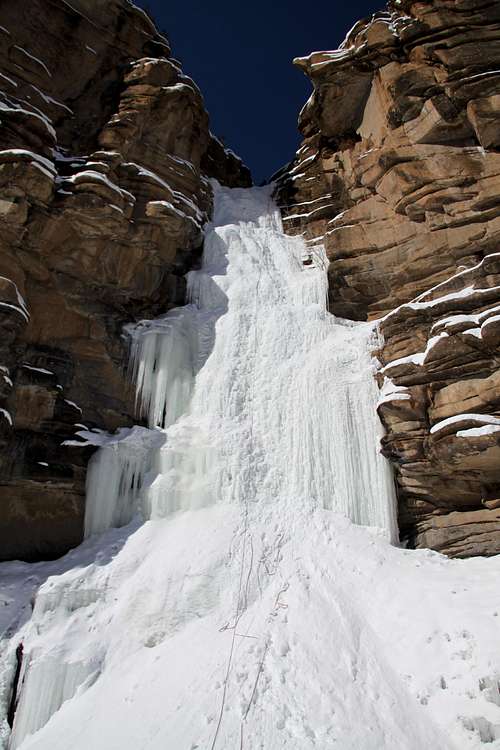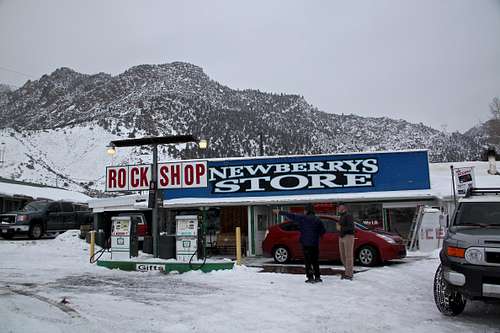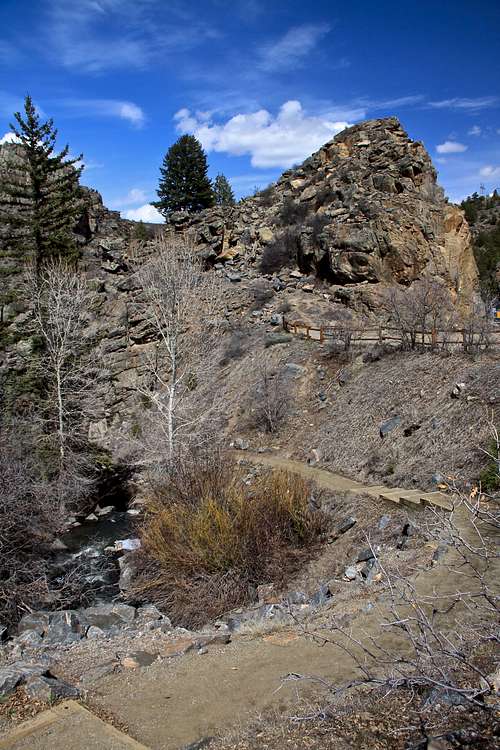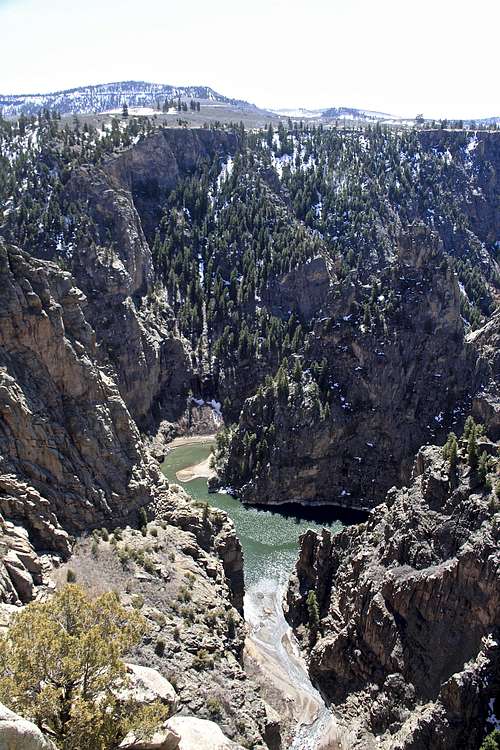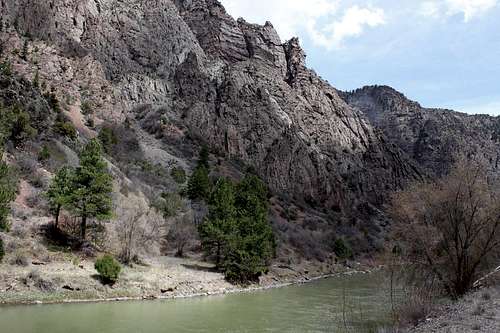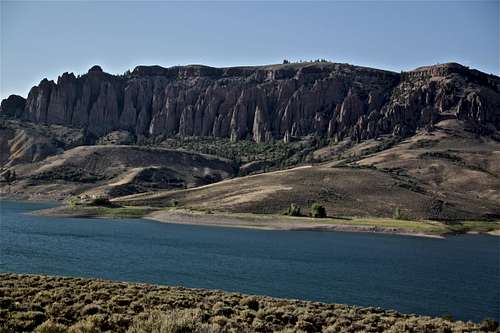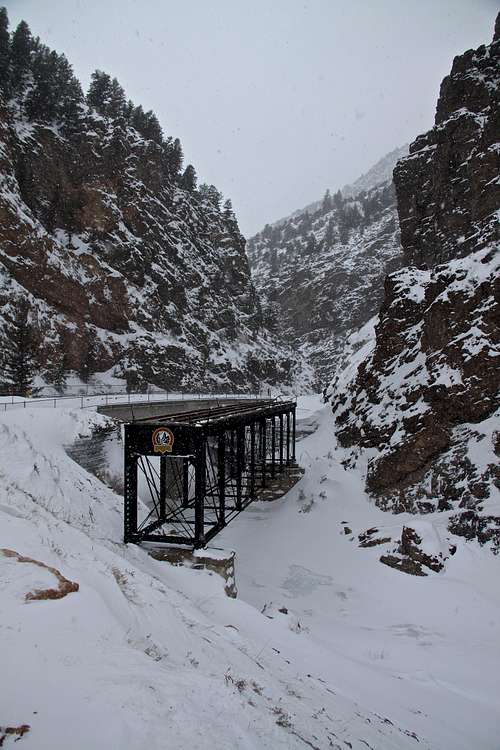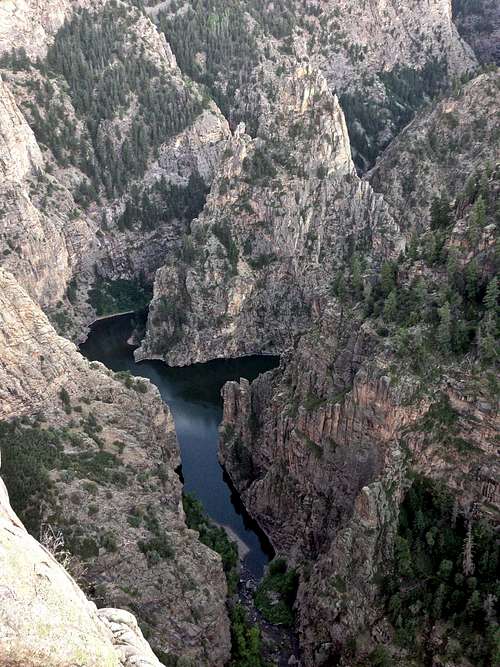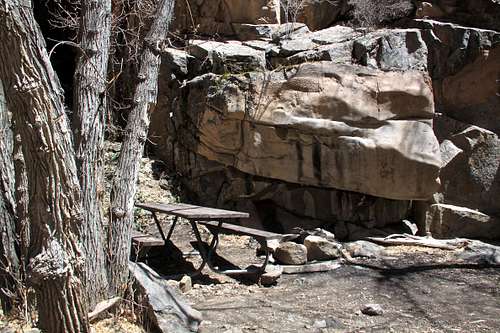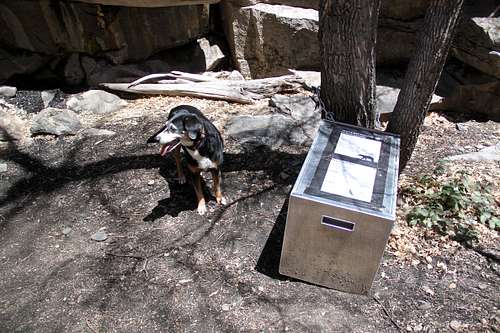-
 12658 Hits
12658 Hits
-
 91.14% Score
91.14% Score
-
 34 Votes
34 Votes
|
|
Area/Range |
|---|---|
|
|
38.46650°N / 107.16689°W |
|
|
Hiking, Trad Climbing, Ice Climbing, Scrambling |
|
|
Spring, Summer, Fall, Winter |
|
|
7100 ft / 2164 m |
|
|
Overview
Blue Mesa Reservoir is Colorado’s largest body of water. Created by Blue Mesa Dam. Blue Mesa Reservoir is 20 miles long (32 km), has 96 miles (154 km) of shoreline, and is the largest Lake Trout and Kokanee salmon fishery in the United States. Blue Mesa reservoir was completed in 1945.
12 miles below Blue Mesa Dam is Morrow Point Dam. Morrow Point Dam was completed in 1967 creating Morrow Point reservoir. While the primary purpose of Blue Mesa Dam is to store water, the primary function of Morrow Point is to produce hydroelectricity.
Crystal Dam is a double curvature thin arch dam located six miles (10 km) downstream from Morrow Point Dam. Crystal Dam is the newest of the three dams in Curecanti, its construction was finished in 1976, forming Crystal Reservoir. Below Crystal Dam is the East Portal of the Gunnison Tunnel, a National Historic Civil Engineering landmark. Just below East portal is the eastern boundary of Black Canyon of the Gunnison National Park.
What does the name "Curecanti" mean? Curecanti National Recreation area is named after a Ute Indian sub-chief who roamed through eastern and souther Colorado from the 1860s to 1870s.
Getting There
Curecanti National Recreation Area is located approximately 200 miles southwest of Denver.
Map of Curecanti NRP from national park service - click here
U.S. Highway 50 runs the length of Curecanti between Montrose and Gunnison, Colorado. The recreation area is also accessed from CO Hwy 149 and CO Hwy 92.
Public Transportation: complicated, by bus or trail to Grand Junction, and then hitchhike
Plane: Commercial airline service available to Gunnison, Montrose, and Grand Junction. You can rent a car at the airport.
The area would be great to tour on bicycle (lots of hills) and the East Portal Road (paved) leading to the bottom of Black Canyon and Crystal Dam is one of the steepest roads t in Colorado. It has 16% grade.
Hikes in Curecanti
Curecanti is known more for its water based activities, uniformed hikers don't know that Curecanti National Recreation Area has many excellent places to hike, and one of my favorite hikes in the area (including Black Canyon and Gunnison Gorge) is below described Curecanti Creek Trail. You don't need to obtain a permit or pay a day-use fee to hike in Curecanti NRA, or to use several primitive campsites in the NRA (some accessible by trail, some by boat only).
Neversink Trail - The pretty Neversink Trail is popular with birders because of its proximity to a great blue heron rookery. This flat, easy to follow trail is wheelchair accessible, winding its way along the north bank of the Gunnison River through a riparian environment of the cottonwoods, willows, and wildflowers. There are benches to rest at along the way, perfect for observing the bird life. The river is sometimes wadeable, attracting fishermen and children intent on exploring around the pools and shallows. The trail leads east from the parking lot of the Neversink Picnic Area, 5 miles west of Gunnison off the south side of US-50. Pick up a Neversink Trail Guide at the parking area.
Length: 1.5 miles round trip, minimal elevation change
Cooper Ranch Trail - Less than 1.0 mile west on US-50 from the Neversink Picnic Area is another pretty spot along the river. The Cooper Ranch Trail begins in the parking lot of the picnic area with the same name. Once again, the river is often wadeable here and you can follow trails along either bank. The easy trail goes west, in and out of grooves of cottonwood, brush and grassy meadows. Eventually the nice trail peters out, but a fisherman's fainter trail continues along the river all the way to the shore of Blue Mesa Reservoir. The access road to the picnic area is closed in winter, but you can park at the gate closure and walk, ski or snow shoe in.
Length: 0.5 miles
Dillon Pinnacles - The interesting Dillon Pinnacles Trail explores the contrast between the semi-arid landscape, with is weirdly eroded volcanic pinnacles, and Blue Mesa Reservoir. Drive west on US-50 for 21 miles from Gunnison and turn off into the parking lot at the north end of Middle Bridge, which spans the lake. Walk down toward the boat ramp and take a right turn onto the path. It follows the shore of the reservoir a short distance, then climbs through open sagebrush before dropping into Dillon Gulch. At a fork with a jeep track go left and, traversing below the pinnacles, reach a lookout point marked by a short loop. There are wonderful views of the lake, the distant San Juan Mountains and the pinnacles, with benches along the way and plagues that explain the geology. The rock is a conglomerate called breccia, formed by volcanic activity north in the West Elk Mountains, then carved by erosion into strange shaped hoodoos. For a longer and harder hike, go north up the jeep track in the gulch for about 1 mile steeply up to the top of the mesa for fantastic views.
Length: 4 miles round trip, 600 feet ascent.
Pine Creek Trail - this short, popular trail provides access to the Black Canyon below the Blue Mesa Dam for hikers, fisherman, boaters (hand carried craft only) and for those taking the ranger lead boat tour on Morrow Point Reservoir. The trail descends 180 feet into the canyon via 232 steps, following lovely cascading Pine Creek Trail as it cascades merrily down to the river. There's an overlook along the way with an upstream view of the nearly 400 foot tall face of Blue Mesa Dam, straddling the canyon's steep walls. The trail crosses the creek, then descends to the riverbank, where you stroll west along the old gauge railroad bed beside the river to the launch point for the boat tour. The path follows the route of the so called Denver and Rio Grande Western's "Scenic Line of the World" which plied through the eastern end of Black Canyon for nearly 70 years. Interpretive signs along the way explain the geology of the area. There are several picnic tables that offer shady resting spots. At times of low water, you may continue along the historic rail bed beyond the boat launch, to a point where it is submerged by the lake waters. To get to the trailhead for the Pine Creek Trail, head west on US-50 for 1 mile beyond its junction with CO-92. Turn right at the sign unto a steep road and follow it shortly to a small parking area.
Length: 2 miles round trip, 180 feet descend (55 meters) via steps.
Mesa Creek Trail - short, scenic hike below the Morrow Point Dam along the Gunnison River leading to Crystal Reservoir. The hike starts off Hwy 50, turn towards the Cimarron Visitor Center, vintage train exhibit, and campground, and drive to the end of the paved road. The railed overlook offers a view of the confluence of Cimarron Creek and the Gunnison River and the canyon downstream. To the south of the parking lot, railroad locomotive Number 278, along with a tender, boxcar, and caboose sit atop the last remaining piece of trestle. A memento of the railroad's heyday, it was one of the engines that pulled trains through the Black Canyon on the "Scenic Line of the World" until the line was closed in the 1940s. From the parking lot the dirt trail descends the slope to the river at an easy grade. If you choose, you can walk up a short distance toward the dam to get a good view of the hydroelectric generating plant. The trail crosses the river on a steel foot bridge and continues along the north side of the stream. A small shaded bench just over the bridge offers a genial resting place. The sheer walls and extreme narrowness of the Black Canyon are appreciated along this trail as views from the base of the Morrow Point Dam.
Length: 1.5 miles round trip
Curecanti Creek Trail - Lovely Curecanti Creek (my favorite hike in the area) rolls down to Morrow Point Reservoir, it could be made as an overnight trip not because of length or difficulty, but because of its beauty, amazing scenery and great camping down below. The trip takes about 2 hrs only, but the fine campsites at the bottom are asking you to stay overnight. It provides access to the famous Curecanti Needle, and this is on my wish list to come back back with a boat, get across the river and climb this landmark. The hike begins at the Pioneer Point Overlook, off CO-92, 5.7 miles west of its junction with US-50. Take a moment to check out the railed overlooks for one of the best views in Curecanti NRA. Your route descends the canyon to the west. Follow the sign from the parking lot, traversing northwest down through open pine and scrub forest. Once into the canyon alongside the cascading creek, the trail turn south and becomes steeper, descending through rock steps, and crossing the creek on two foot bridges. About half way down, there is a pretty picnic area set in a meadow with table and grill. The trail ends where the creek spills out into a small inlet on the reservoir. Nearby are a couple of tent sites with picnic tables, fire grates, bear safe container, and an outhouse. The sites are free - first come, first served. Across the inlet and the narrow lake, towers the 700 foot (210 meters) spire of the Curecanti Needle. Once famous as the marketing symbol for the Denver & Rio Grande rail line through the upper part of the Black Canyon, it's made up of Curecanti quartz monzonite, a light colored, fine grained granite.
Length: 4 miles round trip, elevation change 900 feet (270 m).
Hermit’s Rest Trail - this is the most strenuous hike in Curecanti NRA; but although rated difficult due to the elevation that must be regained on the return, the trail is of high standard with plenty of switchbacks to spread out the rise and with benches placed for resting. Bring lots of water - there's none along the trail and this south facing slope can get pretty warm when climbing out on a summer afternoon. Zigzagging through oak, pine, juniper, and fir, hikers descend to wooded camp and picnic sites on the shores of Morrow Point Reservoir. Campsites with picnic tables, fire grates and toilets are provided at the end of the trail. The trail starts off Hwy 92 at the National Park Service "Hermit's Rest" sign. The trail begins just beyond the picnic pavilion at the west end of the parking lot. Because this hike drops 1800 vertical feet over three miles, the going is steep. Switchbacks make the descend manageable and not extreme. When estimating your travel time, figure it will take you twice as long to ascend as descend. One and a half hours down and three hours up are average. Midway down you enter a pinyon forest, and the switchbacks become shorter and the descent steeper. Benches are placed to take advantage of shade and scenery (very convenient on your way up).
Length: 6 miles, elevation change: 1,800 feet (550 m)
Crystal Creek Trail - Winding through abundant wildflowers, oak, aspens, conifers and a recovering burn area, Crystal creek trail is ideal for spring or fall hiking. Sweeping views of Cimarron Valley, the West Elks and San Juan Mountains can be viewed along the way. The trail ends at an overlook, 1,800 ft (550 m) above Crystal Reservoir. The trail starts at the turn off from Hwy 92, there is a sign for the trail at the parking lot. There is also an outhouse and picnic table. The trail is hard packed dirt most of the way with occassional rock fragments. It winds along the ridge, with switchbacks at steeper sections. Three evenly spaced wooden benches along the path make for comfortable rest stops to take in the majestic panoramas. The trail before the first overlook offers magnificent views of the Cimarron Valley, Poverty Mesa, Uncompahgre Peak, and the San Juan mountain range to the south. The second bench looks north to the West Elk mountain range with the peaks of Land's End, Lamborn, Saddle Mountain, and Cathedral Peak clearly visible from left to right (west to east)
Length: 5 miles round trip, elevation change 525 feet
Ice Climbing in Curecanti
Rock Climbing
Boating
Red Tape
There is no entrance fee for Curecanti. Visitors traveling to East Portal through the Black Canyon of the Gunnison National Park entrance must pay 15$ per vehicle. It covers all persons in a single, private, noncommercial vehicle and is valid for seven calendar days.Curecanti NRA is open year round. Pets friendly.
Curecanti NRA is spread over a large area and receives many visitors (nearly 900,000 per year) that there are several visitor and information centers.
The Elk Creek Visitor Center, 16 miles west of Gunnison on US-50, is the primary center, as well as the headquarters for the National Park Service. It's open mid May through late September, and open on weekends during the rest of the year. You can ask rangers about boating and fishing conditions and obtain the necessary boating permit for Blue Mesa Reservoir.
The Lake Fork Information Center is located 25 miles west of Gunnison on CO-92, just north of its junction with US-50. Lake Fork is only open from mid Ma to late September. You'll find a ranger on duty and a small retail outlets where books, maps, postcards are sold.
Cimarron Information Center is further west along US-50, 35 miles from Gunnison. It is open summers only. This is a must stop for railroad buffs who will be interested in the photo exhibit about the days when the Denver and Rio Grande Western Railroad high-balled through the canyon.
East Portal accessed just past the entrance to Black Canyon of the Gunnison National Park requires a fee as mentioned above. The road is paved, but closed during the winter. It is very steep, winding road (16% grade). There is an information station at the bottom with info about both Curecanti NRA and the National Park.
Ranger Programs
- Morrow Point Boat Tour: Join a park ranger for a leisurely boat ride along the Morrow Point Reservoir. Tours operate twice daily, except Tuesdays, late May through early September (Memorial Day to Labor Day), at 10:00 am and 12:30 pm. Non-refundable, prepaid reservations are required. Call for reservations (970) 641-2337, ext. 205 or stop by the Elk Visitor Center (15 miles west of Gunnison off Hwy 50) to make reservations. Walk ons are not permitted. Fee: adult 16$, children under 12 8$, seniors 8$. Photos from Morrow Point Boat tour here
- Night Hike: Enjoy the spectacular stargazing at Curecanti by joining a night hike. Location and dates may vary to take advantage of full moons and dark skies. Free reservations are required. Again, call Elk Creek Visitor Center (same number and extension as above).
- Other Ranger Programs: A variety for all ages, including Junior Ranger activities, are offered throughout the summer season.


